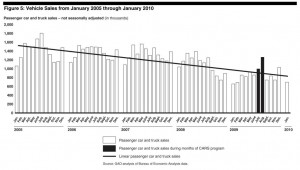The House Committee on Energy and Commerce is interpreting a new General Accounting Office study of the “Cash for Clunkers” program as saying it met key goals of stimulating the economy and improving vehicle fuel economy.
If only it were that simple.
The press release from the Committee selectively quotes the GAO in what appears to be an attempt to justify the Administration’s economic policies in an election year.
The new GAO report, Lessons Learned from Cash for Clunkers Program, “confirms the beneficial impacts of the CARS program,” according to the Committee headed by Henry A. Waxman, a Democrat from California.
“The CARS program is a classic example of how good environmental policy can also be good economic policy,” said Chairman Waxman. “And it shows how Congress and President Obama have worked to get the American economy moving.”
GAO reviewed two key program goals: stimulating the economy and putting more fuel-efficient cars on the road, and concluded, “The program achieved these broad objectives.”
However, the report also says, “the extent to which it did so is uncertain. For example, nearly 680,000 consumers purchased or leased vehicles using the program’s credit, yet some of these sales would have happened anyway.”
This is not the first study on Clunkers, of course.
A December 2009 review of the program by the National Highway Traffic Safety Administration (NHTSA) found that almost 700,000 new cars were purchased or leased under the program, which increased GDP by as much as $6.8 billion, created or saved over 60,000 jobs, and will result in estimated greenhouse gas emissions reductions of nine million metric tons.
Here, GAO is also skeptical: “In its report to Congress, the agency (NHTSA) estimated that 88% of the 677,842 CARS transactions approved at the time of its report were directly attributable to the program. Additionally, NHTSA found that the average combined fuel economy of new vehicles purchased or leased under the program was 24.9 miles per gallon, compared with 15.7 miles per gallon for vehicles traded in. According to the agency, however, the entire difference in combined fuel economy may not have been a direct result of the program. NHTSA also estimated that the program reduced fuel consumption for the typical CARS participant.”
“NHTSA based these estimates on a consumer survey that it designed and implemented. However, largely because it had limited time to establish and administer the program, NHTSA did not follow some generally accepted survey design and implementation practices, thereby posing a potential risk to the reliability of estimates based on the survey data.” GAO said.
April new-vehicle retail sales are expected to come in at 804,200 units, which represent a seasonally adjusted annualized rate (SAAR) of only 9.8 million units. (See April U.S. Retail Auto Sales) This means that the debate on whether some form of Clunkers should be revived will begin anew. It is an election year.
(If you look at the economy, which includes the highest unemployment rates since the Great Depression, and the still damaged and still unregulated financial practices that caused the ongoing global Great recession, there is room to wonder if our elected representatives are worth their lavish salaries and benefits. However, that is another story.)

